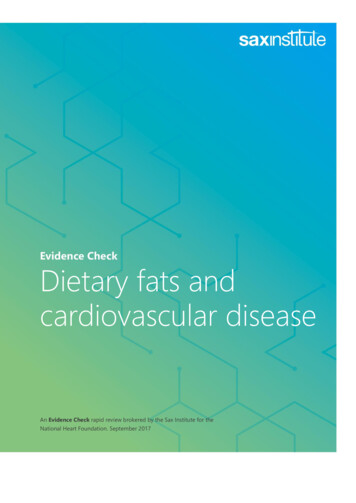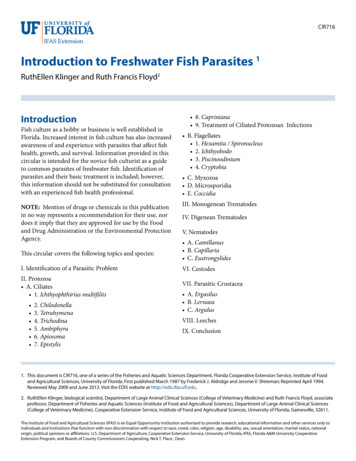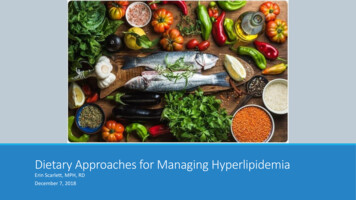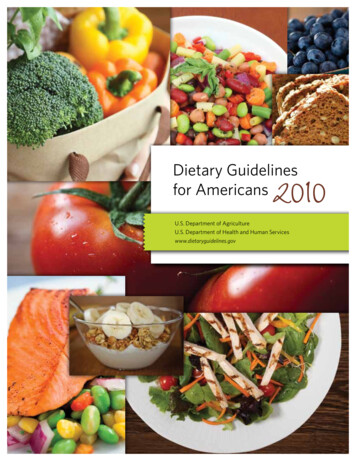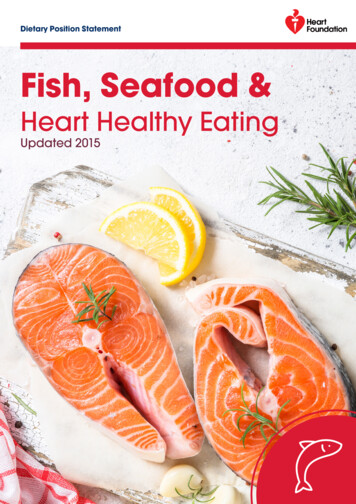
Transcription
Dietary Position StatementFish, Seafood &Heart Healthy EatingUpdated 2015
1DIETARY POSITION STATEMENT FISH AND SEAFOODPosition StatementPeople who regularly consume diets high in fish tendto have lower risks of a range of conditions includingheart disease, stroke, macular degeneration anddementia in older adults.1 Fish provides energy(kilojoules), protein, selenium, zinc, iodine andvitamins A and D, as well as omega-3 long-chainpolyunsaturated fatty acids (omega-3) to the diet.1This position statement outlines the HeartFoundation’s stance on fish and seafood as part ofa healthy eating pattern for the primary preventionof heart disease. It is informed by a summary ofevidence commissioned by the Heart Foundation2,other reputable guidelines and an analysis ofAustralian dietary intake.
2DIETARY POSITION STATEMENT FISH AND SEAFOODHeart Foundation positionAs part of a heart-healthy diet based on a variety of foodsincluding vegetables, legumes, fruit, wholegrain cereal, leanmeats and their alternatives, reduced fat milk, cheese andyoghurt and alternatives, nuts, seeds and healthier oils, andlimiting salt, the Heart Foundation recommends:2 all Australians aim to include 2–3 servings of fish (includingoily fish) per week which provides about 250–500 milligramsof marine-sourced omega-3s, eicosapentaenoic acid (EPA)and docosahexaenoic acid (DHA), per day.The Heart Foundation recommends people with existing heartdisease should also aim for 2–3 servings of fish and seafood aspart of a heart-healthy diet.Evidence overviewNestel et al2 present an assessment of the evidence foromega-3 consumption and cardiovascular health publishedbetween 2007 and 2013, and this informs the Heart Foundationrecommendations. This review assessed and graded theevidence, using the National Health and Medical ResearchCouncil (NHMRC) framework, in relation to fish consumptionand omega-3 supplementation.There were two distinct aspects to the review. The firstconsidered the evidence for preventing a first heart attackin those without prior heart disease and then in those withexisting heart disease who were at risk of further heart attacks.The second aspect was a review of separate studies thatinvestigated the benefit of eating adequate amounts of fishand clinical trials of the value of taking fish oil supplements. Inpeople without existing coronary heart disease (CHD), a metaanalysis of 17 cohorts3 found that compared with the lowest fishintake ( 1 serving/month or 1–3 servings/month), either low (1serving/week) or moderate (2–4 servings/week) consumption offish was associated with a significant reduction in CHD mortality(0.84, 95%CI 0.75–0.95; 0.79, 95%CI 0.67–0.92 respectively)consistent with other studies also confirming this inverseassociation.4–8 A daily intake of 250–500 mg omega-3 from fishwas associated with reduced CHD risk.3, 8 Based on these data,the evidence remains supportive of fish consumption, includingoily fish, to reduce the risk of CHD (Grade C).
3DIETARY POSITION STATEMENT FISH AND SEAFOODThe evidence was limited in people with existing CHD (as abroad category),9, 10 but when heart failure was the primaryoutcome, a modest inverse association between fishconsumption and incidence of heart failure was observed. Ameta-analysis of seven prospective cohort studies that involved176,441 subjects with 5,480 incident cases of heart failureshowed that high fish intake was protective against developingheart failure.11 The Cardiovascular Health Study examined 4,738US adults older than 65 and free of heart failure at baseline.12After 12 years, 955 patients developed heart failure. There wasan inverse relationship between fish intake and incidenceof heart failure. The highest quintile had a 32% lower riskcompared to those who consumed fish less than or equal toonce a month (p trend 0.009). However there was insufficientconvincing evidence for the use of fish oil supplements (theassumed beneficial component in fish) to prevent further heartattack in secondary prevention. Nevertheless further trials arebeing awaited with interest.Table 1 summarises the evidence by NHMRC levels and grade.Table 1. Evidence statements for fish and dietary patterns withomega-3 polyunsaturated fatty acidsEvidence statementLevel ofGrade ofevidence evidenceIn the studies published since 2008,there is good evidence that increasedconsumption of fish or dietary patternswith omega-3 are associated with theprimary prevention of CHD.4–8III BThere is insufficient evidence n/a n/a(n 3 studies) published since the2008 paper to assess the relationshipbetween fish consumption or dietarypatterns with omega-3 in secondaryprevention of CHD.There is some evidence for a modestbenefit from eating fish and omega-3supplementation in addition tostandard therapy in heart failure.11–15II CIn view of the summary of evidence, and the evidencestatements, the Heart Foundation recommendations for theprimary prevention of coronary heart disease are: As part of a heart-healthy eating pattern, aim for 2–3 servesof fish (150–200g), including oily fish, per week to achieveabout 250–500 mg per day of combined DHA and EPA.You can access the evidence review and recommendationson omega-3 and cardiovascular disease, including omega-3supplementation, at tract
4DIETARY POSITION STATEMENT FISH AND SEAFOODNational and internationalguidelinesThe Australian Dietary Guidelines recommend at least twoserves of (any) fish per week1 in the Australian Guide to HealthyEating. The guidelines acknowledge that the protective effectof fish consumption is most likely mediated through omega-3,however due to the guideline reviewing the evidence for foodonly, they do not specifically make a recommendation foromega-3 supplements.Internationally, guidelines published in the last five yearsreflect similar conclusions. European guidelines recommendthe consumption of fish at least twice a week, with one ofthe serves as oily fish.16–18 The European Society of Cardiologyrecommends increasing omega-3 through fish consumption,rather than from supplements, for patients with stable heartdisease.17 The National Institute of Clinical Excellence (NICE)recommends the consumption of at least two servings offish, one being oily, per week and advises against routinerecommendation of omega-3 supplements.9These international guidelines are consistent with therecommendations made by Nestel et al2 and reflect theHeart Foundation recommendations outlined in this positionstatement.Practical considerations forfish and seafood consumptionOmega-3 content of fish and seafoodThe EPA and DHA composition of common fish and seafood inAustralia has seen some modest changes since the last HeartFoundation review of evidence.20The amount of EPA and DHA in fish is a reflection of their dietand environment. Changes in fish feed ingredients has adirect impact on the EPA and DHA content of farmed fish andseafood. For example, recent Australian research reveals theomega-3 content of farmed Atlantic salmon and barramundihas decreased significantly in the last decade, althoughthey still remain a rich source.21 Updated Heart Foundationresources and composition tables reflect the highest qualityfood composition data currently available in Australia.22, 23 TheHeart Foundation resource ‘Sources of omega-3s’ outlines thelevels of omega-3 in different fish and seafood types. The idealrange for omega-3 consumption was updated to 250–500 mgof EPA and DHA per day, so there is a wider variety of fish andseafood that can be eaten to meet this goal.
4DIETARY POSITION STATEMENT FISH AND SEAFOODMercury in Australian fish and seafood speciesThe Heart Foundation supports the Food Standards Australiaand New Zealand (FSANZ) recommendations to avoid mercurycontamination. Due to the higher presence of mercury insome species of fish, these should be limited, especially duringpregnancy.24 The Heart Foundation consumer resources do not listany high-risk species such as flake, swordfish and orange roughy.Sustainability of Australian fish and seafood speciesSustainability of our food supply is an important part of makingfood choices. The Heart Foundation advises people interestedin making sustainable fish and seafood choices to consult othernational guidelines for more information.Fish consumption in AustraliaThe Australian Health Survey22 2011–2012 reports that around1 in 5 Australians ate fish or seafood products.* Fish andseafood products (including fresh fish, packed, canned fishand fish from takeaway outlets) are the main contributors toomega-3 intake, and provide the largest proportion of omega-3compared with any other food group.† It is difficult to measurewhether Australian’s are reaching the Heart Foundation’srecommendations for omega-3 intake (250–500 mg of EPA andDHA per week) as current dietary survey data does not reportthe frequency of fish consumption over an entire week.Omega-3 supplementsBecause our bodies cannot produce omega-3s, we need tosource them through diet. The scientific evidence supports fishas the best dietary source of omega-3s and found higher fishintake was consistently associated with lower rates of heartdisease (heart failure and sudden cardiac death) and stroke.2For people who do not eat fish, supplements will provide somelevel of marine-sourced omega-3s.You can access the evidence review and recommendationson omega-3 and cardiovascular disease, including omega-3supplementation, at tractFSANZ recommendations to reduce the risk of mercury exposureare 2–3 serves per week of any fish except the following, whichshould be eaten infrequently: One serve per week of orange roughy (deep sea perch) orcatfish. No other fish that week. One serve per fortnight of shark (flake) or billfish (swordfish/broadbill or marlin). No other fish that fortnight.* Nineteen per cent of adults ( 19 years old) reported eating fish or seafood on theday of the survey.† For all surveyed adults ( 19 years old) approximately 58% of the total daily omega-3intake came from ‘fish and seafood products and dishes’.
4DIETARY POSITION STATEMENT FISH AND SEAFOODRecommendations The Heart Foundation recommends all Australians shouldaim to include 2–3 serves of fish (including oily fish) per weekas part of a heart-healthy diet. This provides around 250–500milligrams of marine omega-3s (EPA and DHA) per day.1, 2 Recommendations for fish are consistent with therecommendations of FSANZ and the NHMRC.1, 2, 24 Omega-3s are an essential part of a heart-healthy diet. Asan essential fatty acid, the human body requires, but cannotmake, omega-3 and so they need to be sourced throughthe diet. Omega-3s can come from marine, animal andplant sources. The scientific evidence supports fish as thebest dietary source of omega-3s and found higher fish intakeis consistently associated with lower rates of heart disease(heart failure and sudden cardiac death) and stroke. Fish with the highest levels of omega-3 include salmon,blue-eye trevalla, blue mackerel, herring, canned sardines,canned salmon and some varieties of canned tuna.Other good sources of marine-sourced omega-3s includebarramundi, bream, flathead, squid, scallops and mussels. People can safely eat 2–3 serves a week of most types offish. However, because of the presence of higher levels ofmercury in some fish there are a few types that should belimited, especially if you are pregnant.24 FSANZ recommends2–3 serves per week of any fish except the following, whichshould be eaten infrequently:o One serve per week of orange roughy (deep sea perch)or catfish. No other fish that week.o One serve per fortnight of shark (flake) or billfish(swordfish/broadbill or marlin). No other fish that fortnight. The Heart Foundation guide to omega-3 levels in fish andseafood and recipes do not list any species for which thereis a higher risk of mercury contamination, such as flake,swordfish and orange roughy.Omega-3 supplements (EPA and DHA) Supplements will provide peoplewho do not eat fish with some level ofmarine-sourced omega-3s. There is evidence omega-3supplements can play a beneficialrole in the treatment of patients withhigh triglyceride levels and patientswith existing heart disease, specificallyheart failure.Plant-sourced omega-3s (ALA) All Australians should aim for 1 gram ofplant-sourced omega-3 (ALA) each day. Plant-sourced omega-3s are related,but slightly different, to marine-sourcedomega-3s however both types areimportant parts of a healthy diet.Sources of ALA omega-3 includeswalnuts, linseed/flaxseed, chia seedsand oils such as canola and soybean.
4DIETARY POSITION STATEMENT FISH AND SEAFOODGlossaryAcknowledgementsOmega-3s – Omega-3 fatty acids are a type ofpolyunsaturated fat that, like other dietary polyunsaturated fats,reduce your risk of heart disease.The Heart Foundation thanks themembers of the National CardiovascularHealth team, along with the Food andNutrition Advisory Committee, the ClinicalIssues Committee, the CardiovascularHealth Advisory Committee and theNational Board of the National HeartFoundation of Australia for their reviewand contribution to this position statement.Omega-3s come from marine, animal and plant sources. Theevidence for heart health is much stronger for marine-sourcedomega-3s (EPA, DHA). While plant-sourced omega-3s (ALA) canbe converted in our bodies to EPA and DHA, the conversionrate is low. Therefore it is important to include marine-sourcedand plant-sourced omega-3s from a variety of foods as part ofa heart-healthy diet.Marine-sourced omega-3s – DHA and EPA are omega-3s foundprimarily in oily fish, such as salmon, blue-eye trevalla, bluemackerel, herring, canned sardines, canned salmon and somevarieties of canned tuna. Other fish such as barramundi, breamor flathead, and seafood such as arrow squid, scallops andmussels, are also good sources of omega-3.Plant-sourced omega-3s – ALA is derived from plants and isfound mainly in plant-based fats and oils, such as canola oiland soybean oil, and linseeds (flaxseeds), chia seeds andwalnuts.Animal-sourced omega-3s – Docosapentaenoic acid (DPA),along with small amounts of EPA and DHA, is found in animalproducts, such as free range eggs, chicken and beef.AcronymsALA – Alpha-linolenic acidCHD – Coronary heart diseaseDHA – Docosahexaenoic acidDPA – Docosapentaenoic acidEPA – Eicosapentaenoic acidIndependent advice was providedon issues of omega-3 composition,mercury contamination guidelines andsustainability by Jessica Bogard, Universityof Queensland.
5DIETARY POSITION STATEMENT FISH AND SEAFOODReferences1.National Health and Medical Research Council. Health Australian Dietary Guidelines. Canberra: NationalHealth and Medical Research Council; 2013.2. Nestel P, Clifton P, Colquhoun D, et al. Indications for omega-3 long chain polyunsaturated fatty acid inthe prevention and treatment of cardiovascular disease. Heart Lung Circ 2015;24(8):769–79.3. Zheng J, Huang T, Yu Y, et al. Fish consumption and coronary heart disease mortality: an updated metaanalysis of seventeen cohort studies. Public Health Nutr 2012;15(4):725–37. Epub 2011/09/15.4. de Goede J, Geleijnse JM, Boer JM, et al. Marine (n-3) fatty acids, fish consumption, and the 10-year riskof fatal and nonfatal coronary heart disease in a large population of Dutch adults with low fish intake. JNutr 2010;140(5):1023–28. Epub 2010/03/26.5. Mozaffarian D, Lemaitre RN, King IB, et al. Plasma phospholipid long-chain omega-3 fatty acids and totaland cause-specific mortality in older adults: a cohort study. Ann Intern Med 2013;158(7):515–25. Epub2013/04/03.6. Streppel MT, Ocke MC, Boshuizen HC, et al. Long-term fish consumption 92 and n-3 fatty acid intake inrelation to (sudden) coronary heart disease death: the Zutphen study. Eur Heart J 2008;29(16):2024–30.Epub 2008/07/22.7.Joensen AM, Overvad K, Dethlefsen C, et al. Marine n-3 polyunsaturated fatty acids inadipose tissue andthe risk of acute coronary syndrome. Circulation 2011;124(11):1232–38. Epub2011/08/24.8. Musa-Veloso K, Binns MA, Kocenas A, et al. Impact of low v. moderate intakes of long-chain n-3 fatty acidson risk of coronary heart disease. Br J Nutr 2011;106(8):1129–41. Epub 2011/07/09.9. Manger MS, Strand E, Ebbing M, et al. Dietary intake of n-3 long-chain polyunsaturated fatty acids andcoronary events in Norwegian patients with coronary artery disease. Am J Clin Nutr 2010;92(1):244–51.Epub 2010/05/21.10. Pottala JV, Garg S, Cohen BE, Whooley MA, Harris WS. Blood eicosapentaenoic and docosahexaenoicacids predict all-cause mortality in patients with stable coronary heart disease: the Heart and Soul study.Circ Cardiovasc Qual Outcomes 2010;3(4):406–12. Epub 2010/06/17.11. Djousse L, Akinkuolie AO, Wu JH, Ding EL, Gaziano JM. Fish consumption, omega-3 fatty acids and risk ofheart failure: a meta-analysis. Clin Nutr 2012;31(6):846–53. Epub 2012/06/12.12. Mozaffarian D, Bryson CL, Lemaitre RN, Burke GL, Siscovick DS. Fish intake and risk of incident heart failure.J Am Coll Cardiol 2005;45(12):2015–21. Epub 2005/06/21.13. Tavazzi L, Maggioni AP, Marchioli R, Barlera S, Franzosi MG, Latini R, et al. Effect of n-3 polyunsaturatedfatty acids in patients with chronic heart failure (the GISSI-HF trial): a randomised, double-blind, placebocontrolled trial. Lancet 2008;372(9645):1223–30. Epub 2008/09/02.14. Yamagishi K, Nettleton JA, Folsom AR. Plasma fatty acid composition and incident heart failure in middleaged adults: the Atherosclerosis Risk in Communities (ARIC) Study. Am Heart J 2008;156(5):965–74. Epub2008/12/09.15. Macchia A, Levantesi G, Franzosi MG, Geraci E, Maggioni AP, Marfisi R, et al. Left ventricular systolicdysfunction, total mortality, and sudden death in patients with myocardial infarction treated with n-3polyunsaturated fatty acids. Eur J Heart Fail 2005;7(5):904–9. Epub 2005/08/10.16. McMurray J, Adamopoulos S, Anker SD, Auricchio A, Bohm M, Dickstein K, et al. ESC Guidelines for thediagnosis and treatment of acute and chronic heart failure 2012: The Task Force for the Diagnosis andTreatment of Acute and Chronic Heart Failure 2012 of the European Society of Cardiology. Developed incollaboration with the Heart Failure Association (HFA) of the ESC. Eur Heart J 2012;33(14):1787–847.
5DIETARY POSITION STATEMENT FISH AND SEAFOOD17. Montalescot G, Sechtem U, Achenbach S, Andreotti F, Arden C, Budaj A, et al. 2013 ESC guidelines on themanagement of stable coronary artery disease: the Task Force on the management of stable coronaryartery disease of the European Society of Cardiology. Eur Heart J 2013;34(38):2949–3003.18. Reiner Z, Catapano AL, De Backer G, et al. ESC/EAS Guidelines for the management of dyslipidaemias:the Task Force for the management of dyslipidaemias of the European Society of Cardiology (ESC) andthe European Atherosclerosis Society (EAS). Eur Heart J 2011;32(14):1769–818.19. National Institute of Clinical Excellence. Primary prevention of cardiovascular disease. London: NICE, 2010.20. National Heart Foundation of Australia. Position statement on fish, fish oils, n-3 polyunsaturated fatty acidsand cardiovascular health. Melbourne: National Heart Foundation of Australia; 2008.21. Nichols PD, Glencross B, Petrie JR, Singh SP. Readily Available Sources of Long-Chain Omega-3 Oils: IsFarmed Australian Seafood a Better Source of the Good Oil than Wild-Caught Seafood? Nutrients 2014;6:1063–79.22. Australian Bureau of Statistics. Australian Health Survey: Nutrition First Results – Food and Nutrients, 2011–12.Canberra: ABS, 2014.23. Food Standards Australia New Zealand. AUSNUT 2011–13 – Australian Food Composition Database.Canberra: FSANZ, 2014. Available at ts/ausnut/Pages/about.aspx (Accessed July 2014).24. Food Standards Australia New Zealand. Mercury in Fish: Food Standards Australia and New Zealand.Canbera: FSANZ, 2015. Available at y/pages/default.aspx. Accessed 20 Feb 2015.For heart health information and support, call ourHelpline on 13 11 12 or visit heartfoundation.org.auTerms of use: This material has been produced by the National Heart Foundation of Australia (Heart Foundation) for the information of health professionals. The HeartFoundation does not accept any liability, including for any loss or damage, resulting from the reliance on the content, or its accuracy, currency or completeness.Please refer to the Heart Foundation website at www.heartfoundation.org.au for Terms of Use. 2015 National Heart Foundation of Australia ABN 98 008 419 761HH-PFN-008.1.0919
as part of a heart-healthy diet. This provides around 250–500 milligrams of marine omega-3s (EPA and DHA) per day.1, 2 Recommendations for fish are consistent with the recommendations of FSANZ and the NHMRC.1, 2, 24 Omega-3s are an essential part of a heart-healthy diet. As an

